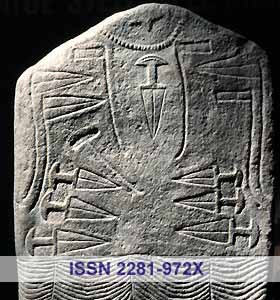TRACCE no. 7 – by Rodrigo Aguiar
The petroglyphs of Santinho Beach S.ta Catarina Island (Brasil)
Santinho beach, situated in S.ta Catarina Island, 40 Km far from Florianópolis town, shows three rock art sites, engraved on its rock walls. The coast is a good place for fishing and shell collecting.

Series of pecked points
In the southern side, distant about 100 m from the coast rock walls, runs a stream of pure water, which probably satisfied the water needs of the prehistoric peoples.
Until now, we have no proof of settlement in Santinho beach. The nearest site is in the north, crossing the dunes, in Ingleses beach. Those sites have not been deeply investigated, but I can argue, through a surface collection and ceramic analysis, the existence of the Itararé and of the Guarani cultures.

Tracing photographed in escale of 15 cm
The site is not well preserved, and remains of sambaqui show the possibility of a hunters-gatherers preceramic occupation. It’s very strange that we have no vestige of rock art in Ingleses beach, even with favorable conditions such as the abundance of the diabase rock. However, we have a great number of lithic stations (sharp and polished implements), perhaps the biggest site of lithic stations in S.ta Catarina Island.
Making a typologic analysis of the petroglyphs in Santinho Beach, the predominant type is represented by the circles, showing a variation of 8 subtypes and totalizing 20 elements; the most frequent subtypes are the series of filled triangles (silhueta), and between them the double parallel series (repeated 6 times, totalizing 12 elements), which is a theme commonly repeated regionally in the painted decorations of the Guarani ceramic, in the interior of the S.ta Catarina State. Locally we have a corrugate style.
The survey resulted in the cataloguing of 105 engraved figures. Among them we can find not only very well preserved signs but also more faced figures, which we can see only from 6:00 to 8:00 a.m. (from December to March).

pecked circle
Of those 105 figures:
- 44 are not repeated;
- 8 are repeated 2 times;
- 3 are repeated 3 times;
- 6 are repeated 4 times;
- 2 are repeated 6 times.
The techniques employed are the pecking and the polishing (diabase rock). There are 83 polished engravings, 19 pecked and 3 with both techniques. This demonstrates that in many cases (but I don’t believe in all cases) the engravings were previously prepared by pecking and afterward polished.
About the engraved lines, the largest is 3.3 cm and the smallest is 1.1 cm. Breadth average is between 1.5 and 2 cm. The deepest engraving line reaches 5 mm in rectilinear figures and 7 mm for ensembles of points in series, but the majority is of plain engravings measuring less than 1 mm in depth.
The biggest petroglyph measures 76 x 140 cm and the smallest 9 x 9 cm (engraved area).
I recorded measures, engraving techniques, preservation, place and name of the site, alterations of the rock, and others points.
Besides photos and slides, plastic sheets in natural size were traced. The traced sheets were reduced by photography and related to a scale of 15 cm. All the information I acquired was placed in a computer, in order to organize a database.

filled triangles superimposed on an anthropomorphic figure
Santinho beach sites present 3 superimpositions.
- The first, in the south coast rock wall, is a curvilinear figure with breadth engraving lines superimposed on a rectilinear figure made by a thin engraved line, which is visibly more faced than the first one.
- The second superimposition, as well as the third, is situated in the second site of the north coast rock wall: we can see three horizontal parallel series of filled triangles superimposed on an anthropomorphic figure made by a thin engraved line.
- The third is a rectilinear figure superimposed on a curvilinear one. They present the same technique of confection, and there is no variation in consumption. So in this case we can hypothesize that the figures are contemporary.
The two first superimpositions may suggest there were two periods of rock art activity, represented by a polishing technique.
The first rock art period could be represented by the thin engraved lines, which are more faced. The second period could be characterized by the broad engraved lines, which show more preserved figures.
It’s really difficult to define clearly the rock art periods, having only 3 superimpositions to analyze. I hope that collecting all the data and analyzing S.ta Catarina Island and adjacent islands under a complete survey, I will be able to reach more reliability about periods and styles of the rupestrian iconography of this region.
Many Thanks to Mr. Andrea Arcà for the excellent orientation he gives me.
Rua Álvaro Cardoso No 47, Estreito – Florianópolis















Leave a Reply